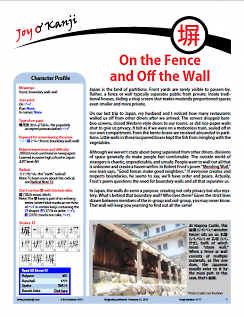塀
fence; boundary wall; wall
Kanji 1777
Thank you for visiting this Character Home Page. Below you'll find a synopsis of the essay. If you wish to read the full text, the PDF of the essay is available for purchase to the right.
Fans of Japanese architecture: this essay abounds in photos! Japanese fences and boundary walls make definitive statements in residential settings and at temples, castles, and restaurants. Learn terms for bamboo and wooden fences, as well as earthen and cinderblock walls. Find out what a black fence represents and what Japan's boundary walls mean culturally and psychologically.
Revision history:
May 19, 2022: pp. 6-7: Made several changes to the photo caption.
Aug. 30, 2021: p. 15, 1st photo caption: I deleted the statement about hedges because they don’t actually qualify as types of 塀, as I'd been told.
June 26, 2021:
- p. 2: Replaced the Henshall etymology with the new one, and did a better job of introducing the Joyo on-yomi and the keyword 塀.
- p. 22: Added a link to the Kanshudo games.
Feb. 9, 2019:
- p. 2: Updated the Sears link.
- p. 9: Revised the translation of the Otomi-san sentence and Sidebar 1.
July 5, 2016:
- p. 3: Deleted the end of a sidebar that said that people use 垣, 塀, and 柵 interchangeably and that dictionaries say that this sort of substitution is acceptable. (My work on 柵 revealed that the distinctions are too great for such interchangeability.)
- p. 7: Revealed 2 lines of text that were inadvertently hidden!
- p. 8: Fixed a broken link.
- p. 9: Deleted the suggestion that Otomi, a woman in a song, was nude. Further discussion in another essay made it seem unlikely that she was nude.
- p. 10: Removed a link to a video that apparently no longer exists online.
Nov. 8, 2013: pp. 6 and 7: Significantly revised the photo caption after reinterpreting the Japanese in the sign.
Oct. 31, 2013: p. 3: Added a definition (prison) to 刑務所, which had none!
Mar. 25, 2013: Fixed a typo on p. 23 and revised a few sentences there.
Feb. 15, 2013: Originally published.



Comments